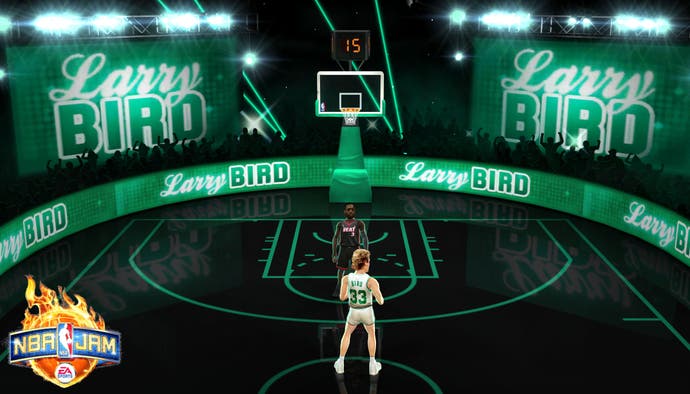NBA Jam
Court short.
As a self-confessed computer nerd who never actually owned a console until the original PlayStation, back in 1993 I was only vaguely aware of NBA Jam from a few brief plays in my local arcade. I had no experience of the home console versions, preferring to sit on my Amiga with the likes of Alien Breed II, Apidya and Cannon Fodder. Yet playing EA's new take on what was apparently considered a coin-op classic – I'll have to take people's word for that; most of my meagre pocket money at that time was spent on copies of Amiga Power and sweets – evoked a weird feeling of nostalgia for a game I barely remember.
Perhaps it's because there's something wonderfully anachronistic about it. As modern sports titles grow ever more complex – you practically need a Masters in Ergonomics to decipher all of FIFA's control convolutions these days – this harks back to a simpler time, where a joystick and three buttons were enough to play pretty much anything.
Sure, EA has done its best to modernise with right-stick controls for shooting, dunking and stealing, but in truth they're pretty unnecessary - not to mention curiously sluggish. It's telling that there's a tutorial for the stick flicks, but not for the basic button controls. Ignoring the curious decision to shun the right trigger and bumper (you'll need to use your left hand if you need a speed boost) they're so intuitive you can jump into a game and figure out how to play within seconds.

For those unfamiliar with the original, it's a fast-paced 2-on-2 game of basketball with no penalties apart from 'goaltending', or interfering with the ball while it's travelling downwards towards the basket. So you can happily shove opponents, steal the ball from them and generally behave in an ungentlemanly and unsportsmanlike way. Maybe that's why EA approached Joey Barton for the promotional campaign.
Each team has a limited shot-clock – the default being 24 seconds – to score before possession changes hands, though unless you're playing a particularly defensive game, that probably won't happen more than a couple of times per match. Like any real basketball game, it's end-to-end stuff, although unlike real basketball, players can seemingly defy the laws of physics, performing feats of impossible athleticism. Your typical alley-oop sees you hurl the ball a good three feet above the basket as your partner makes a prodigious leap to slam it down for two points - and that's before you score three unanswered baskets to set both net and ball ablaze.

Do so, and your shots will suddenly be more accurate, allowing you to rain in three-pointers from ridiculous distances, while dunks get ever more outlandish, as your player pirouettes madly through the air before plummeting backwards towards the basket, occasionally destroying the backboard in the process. One of the myriad game modes sets this very goal, an energy bar depleting with every dunk and alley-oop until an explosion of glass signals the end of the game.
Not only is this massively satisfying, but it also looks terrific. The players are beautifully animated using exaggerated motion capture, and a delightful stylistic flourish sees their heads represented by several digitised photos, the game transitioning between them depending on their position and movement in a manner akin to a forum GIF. It's most noticeable in the Big Head mode, one of a number of modifiers (or 'privileges', as they're called here) that allow you to tweak the game's appearance, with different ball types and visual filters unlocked the more you play.


